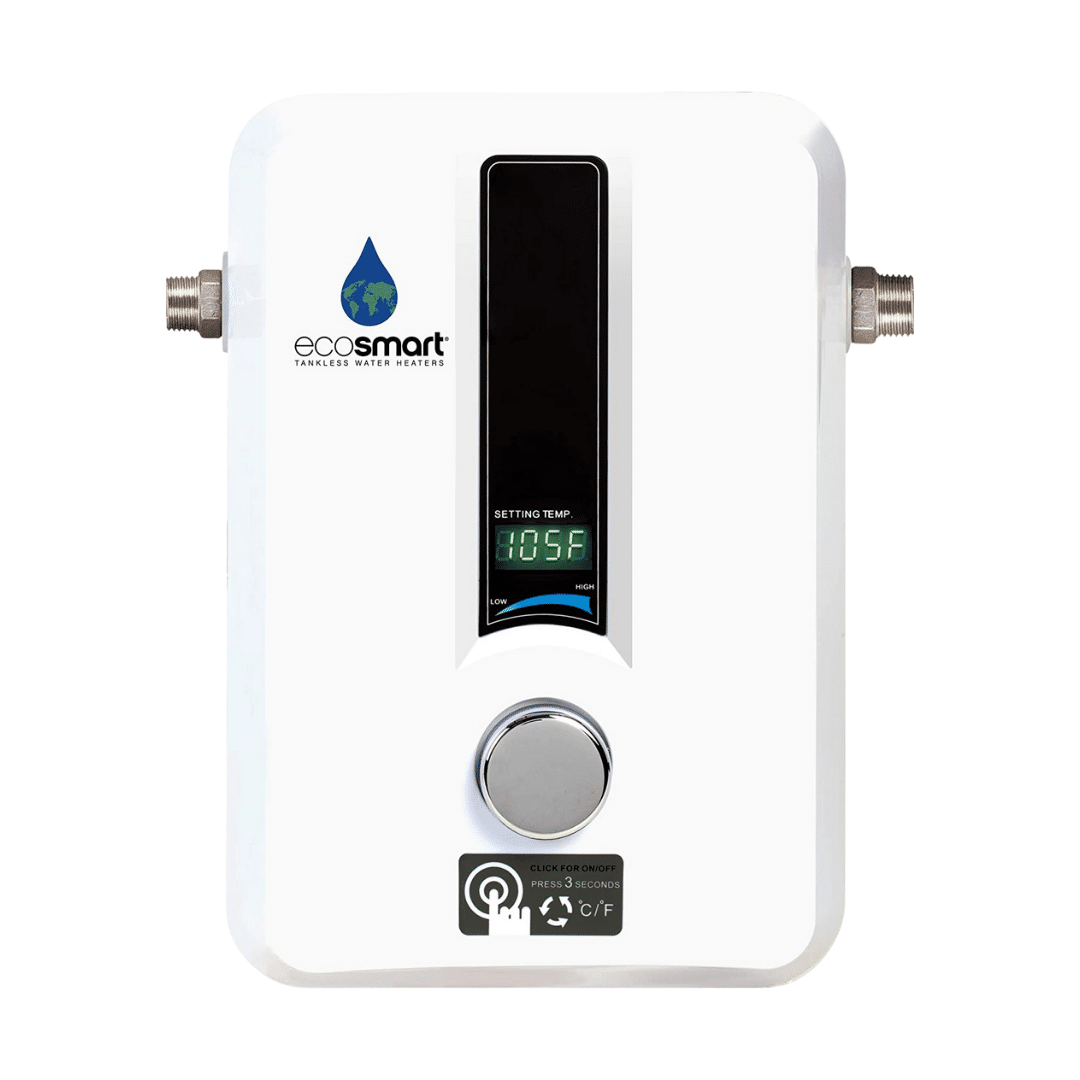If you're currently browsing for the best water heaters in 2022, you may want to check out EcoSmart tankless water heaters. This mid-range option notably has cost-effective upfront costs, and it will further allow you to make more savings with its low operating expenses.
Though it comes at a relatively affordable price, that doesn't mean its quality will get compromised. You can count on your EcoSmart tankless water heater to provide you with hot water on-demand and in an endless supply– FAST.
Now, let's discuss what sets EcoSmart apart from its competitors in detail.
EcoSmart Tankless Water Heaters: Models & Features Overview
One good thing about EcoSmart is how it leverages the latest technological innovation to provide its customers with energy-efficient water heaters. In particular, it offers a patented flow sensor technology to modulate the water heater consumption to meet your demands better. It allows for a lower activated limit than other standard tankless water heaters.
Another notable feature is the automatically resettable thermostat to ensure your convenience. These are more hassle-free than manually-resettable thermostats. EcoSmart offers a wide range of heater variety to meet different household needs– from point-of-use heaters to whole-house systems. You can rely on the brand to provide reliable units that meet safety and quality standards.
Here’s a brief highlight of what to expect in an EcoSmart Tankless Water Heater:
Available Sizes
Since EcoSmart tankless water heaters are available in different sizes, you can start from the smallest 3.5 kW POU unit for point of use service or if you only require low water flow. There are also ECO models of up to 36 kW for whole-house applications.
A critical difference between the two types is that point of use (POU) models do not have the Flow Sensor Technology (unlike whole-house systems). They are much more straightforward to use with their simple ON/OFF option.
The electric units also serve as water heating boosters that help increase the capacity of tank-type units. They're also solar back-ups that provide comfort during the winter months when the solar panels are not as efficient. Some homeowners also use these for space heating purposes on hydronic floors.
Types Of EcoSmart Tankless Water Heaters
The majority of the best-selling EcoSmart water heaters are electric. However, there are also gas heaters (indoor or outdoor units) compatible with natural gas and propane. Making the switch to another fuel is also relatively straightforward, as you will only need to make minor adjustments to the gas valve.
The EcoSmart electric heaters start from $180 (low-flow, POE heaters) to $1,000 for a whole-house unit. Meanwhile, gas heaters range between $750 to $1,800.

ECO 11

ESG-64

POU 3.5
Here’s a table featuring all of EcoSmart’s electric tankless water heaters:
EcoSmart Model | Kilowatts (kW) | Maximum GPM | Warranty Coverage |
|---|---|---|---|
3.5 | 0.5 | 1-year | |
5.5 | 1.5 | 1-year | |
8 | 2 | Lifetime | |
13 | 3.2 | Lifetime | |
18 | 4.4 | Lifetime | |
24 | 5.9 | Lifetime | |
27 | 6.6 | Lifetime | |
36 | 8.8 | Lifetime |
For EcoSmart’s gas tankless models, refer to the table below:
Model | BTU Input | Efficiency | Max GPM | Warranty | Condensing |
|---|---|---|---|---|---|
199K | 0.95 | 9.5 | 12 Years | YES | |
157K | 0.95 | 8.4 | 12 Years | YES | |
199K | 0.82 | 9.5 | 12 Years | NO | |
180K | 0.82 | 8.4 | 12 Years | NO | |
150K | 0.82 | 6.4 | 12 Years | NO |
The electric and gas-powered EcoSmart tankless water heaters modulate the heat input to meet the precise amount of heat. In particular, the ESGH-95 model is designed with a gas valve and burner to operate between 11,000 BTU and 199,000 BTU. As the unit monitors demand, it fires at the required BTU level to give you the hot water you need.
The ECO 27 and 36 are produced in standard and flow control units, with the latter available up to 4 flow restrictors to limit your home's hot water use. EcoSmart's condensing gas water heaters feature a .95 Energy Factor (EF) standard copper heat exchanger. Models with a stainless-steel heat exchanger are more durable, as stainless steel is corrosion-resistant and more efficient.
Units with optional circulation require a pump kit, which costs $350 on average. You will also need to install a recirculation line. Though this will increase the upfront costs, it can be recouped after a few years, mainly if your home uses metered water (instead of a well water supply).
How EcoSmart Water Heaters Compare to Other Brands
Generally, you'll find that some EcoSmart heater models are similar to that of Rheem's. However, unlike other competitor brands, their gas-powered units do not have WiFi control capabilities. (Related: How Does The Noritz Tankless Water Heater Work? (Is It Worth The Premium Cost?))
Online reviews for its tankless water heaters also range from average to good. The models are of good quality, but they lack the extra features you can find in other brands— which keeps them in the mid-price range.
Let's jump into a detailed breakdown below:
Final Verdict
Ultimately, the EcoSmart brand is at the forefront of water heating technology innovations as it enables modulating energy consumption based on a homeowner's particular demand. That said, you can consider an EcoSmart tankless water heater to be a worthwhile investment. The brand's primary mission is to provide high-quality green energy products with economical price points.
Their patented self-modulating technology in their electric tankless water heater line can help you save as much as 60% on your water heating bill instead of settling with outdated methods such as a storage tank. Now is a good time if you're looking for a sign to make the timely switch!
